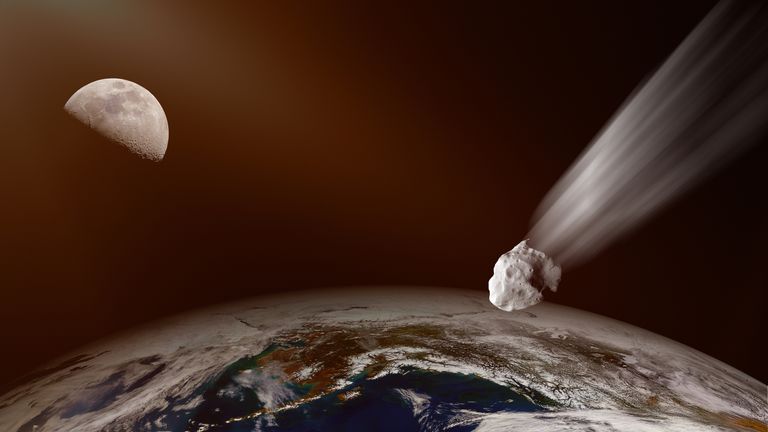Asteroid the size of a bus to hurtle past Earth closer than satellites tomorrow, NASA says
There are thought to be around 100 million asteroids of this size, but they are difficult to detect until they're close to Earth.
Wednesday 23 September 2020 18:40, UK
An asteroid the size of a bus is set to pass Earth at a distance closer than both the Moon and satellites, according to NASA.
The asteroid, named 2020 SW, will fly past 13,000 miles (22,000 kilometres) above the Earth's surface.
This distance means it will be closer than both the Moon and satellites - used for GPS, television and weather - that orbit our plan.
The rock was only discovered on 18 September by the NASA-funded Catalina Sky Survey in Arizona.
It is estimated to be around five to 10 metres (15 to 30ft) wide, making it equivalent to the "size of a small school bus".
Further observations carried out by astronomers identified a trajectory which ruled out any chance of the asteroid colliding with Earth.
"Although it's not on an impact trajectory with Earth, if it were, the space rock would almost certainly break up high in the atmosphere, becoming a bright meteor known as a fireball," the space agency said.
After the asteroid passes at noon, UK time, it will continue its journey around the sun.
This means it will not pass Earth again until 2041, where it will be a greater distance away from the planet.
Although the minor planet's passing will not be visible to the naked eye, people with 12-inch telescopes should be able to spot it.
The passing will also be streamed in a live video feed broadcast by the Virtual Telescope Project.
Paul Chodas, a director at NASA's Jet Propulsions Laboratory, said: "There are a large number of tiny asteroids like this one, and several of them approach our planet as close as this several times every year.
"In fact, asteroids of this size impact our atmosphere at an average rate of about once every year or two."
There are believed to be more than 100 million small asteroids, similar to 2020 SW. However, they are hard to discover until they get very close to Earth.
Larger asteroids, which hold a greater threat if they did collide with Earth, can be detected while further away because they are brighter than small ones.
On 20 August, an asteroid made the closest fly-by of Earth ever recorded. At the time, NASA admitted it had not seen it until after it passed.




